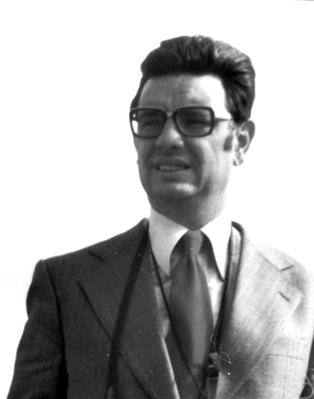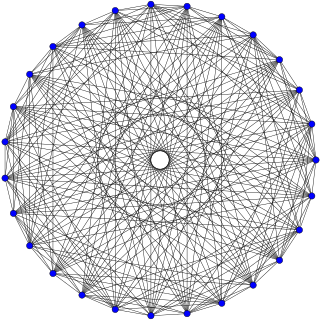Combinatorics is an area of mathematics primarily concerned with counting, both as a means and as an end to obtaining results, and certain properties of finite structures. It is closely related to many other areas of mathematics and has many applications ranging from logic to statistical physics and from evolutionary biology to computer science.

Discrete mathematics is the study of mathematical structures that can be considered "discrete" rather than "continuous". Objects studied in discrete mathematics include integers, graphs, and statements in logic. By contrast, discrete mathematics excludes topics in "continuous mathematics" such as real numbers, calculus or Euclidean geometry. Discrete objects can often be enumerated by integers; more formally, discrete mathematics has been characterized as the branch of mathematics dealing with countable sets. However, there is no exact definition of the term "discrete mathematics".
In mathematics, the factorial of a non-negative integer , denoted by , is the product of all positive integers less than or equal to . The factorial of Failed to parse : {\displaystyle n} also equals the product of with the next smaller factorial:

In mathematics, a permutation group is a group G whose elements are permutations of a given set M and whose group operation is the composition of permutations in G (which are thought of as bijective functions from the set M to itself). The group of all permutations of a set M is the symmetric group of M, often written as Sym(M). The term permutation group thus means a subgroup of the symmetric group. If M = {1, 2, ..., n} then Sym(M) is usually denoted by Sn, and may be called the symmetric group on n letters.

In mathematics, the Erdős–Ko–Rado theorem limits the number of sets in a family of sets for which every two sets have at least one element in common. Paul Erdős, Chao Ko, and Richard Rado proved the theorem in 1938, but did not publish it until 1961. It is part of the field of combinatorics, and one of the central results of extremal set theory.
Combinatorics is a branch of mathematics concerning the study of finite or countable discrete structures.

Béla Bollobás FRS is a Hungarian-born British mathematician who has worked in various areas of mathematics, including functional analysis, combinatorics, graph theory, and percolation. He was strongly influenced by Paul Erdős since the age of 14.

Ben Joseph Green FRS is a British mathematician, specialising in combinatorics and number theory. He is the Waynflete Professor of Pure Mathematics at the University of Oxford.

Sir Henry Peter Francis Swinnerton-Dyer, 16th Baronet, was an English mathematician specialising in number theory at the University of Cambridge. As a mathematician he was best known for his part in the Birch and Swinnerton-Dyer conjecture relating algebraic properties of elliptic curves to special values of L-functions, which was developed with Bryan Birch during the first half of the 1960s with the help of machine computation, and for his work on the Titan operating system.

Jacobus Hendricus ("Jack") van Lint was a Dutch mathematician, professor at the Eindhoven University of Technology, of which he was rector magnificus from 1991 till 1996.
The mathematical field of combinatorics was studied to varying degrees in numerous ancient societies. Its study in Europe dates to the work of Leonardo Fibonacci in the 13th century AD, which introduced Arabian and Indian ideas to the continent. It has continued to be studied in the modern era.
Rosemary A. Bailey is a British statistician who works in the design of experiments and the analysis of variance and in related areas of combinatorial design, especially in association schemes. She has written books on the design of experiments, on association schemes, and on linear models in statistics.
In mathematical logic, an omega-categorical theory is a theory that has exactly one countably infinite model up to isomorphism. Omega-categoricity is the special case κ = = ω of κ-categoricity, and omega-categorical theories are also referred to as ω-categorical. The notion is most important for countable first-order theories.
Norman Linstead Biggs is a leading British mathematician focusing on discrete mathematics and in particular algebraic combinatorics.

In the mathematical field of graph theory, the Schläfli graph, named after Ludwig Schläfli, is a 16-regular undirected graph with 27 vertices and 216 edges. It is a strongly regular graph with parameters srg(27, 16, 10, 8).
Leonid Mirsky was a Russian-British mathematician who worked in number theory, linear algebra, and combinatorics. Mirsky's theorem is named after him.
Combinatorial matrix theory is a branch of linear algebra and combinatorics that studies matrices in terms of the patterns of nonzeros and of positive and negative values in their coefficients.

Jan Saxl was a Czech-British mathematician, and a professor at the University of Cambridge. He was known for his work in finite group theory, particularly on consequences of the classification of finite simple groups.
Martin Liebeck is a professor of Pure Mathematics at Imperial College London whose research interests include group theory and algebraic combinatorics.
John Kenneth Truss is a mathematician and emeritus professor of pure mathematics at the University of Leeds where he specialises in mathematical logic, infinite permutation groups, homogeneous structures and model theory. Truss began his career as a junior research fellow at the University of Oxford before holding a series of academic positions and lastly joining the University of Leeds. He has written books on discrete mathematics (1991) and mathematical analysis (1997) and was co-editor in chief of the Journal of the London Mathematical Society until June 2003. He is the father of the former Prime Minister of the United Kingdom, Liz Truss.










